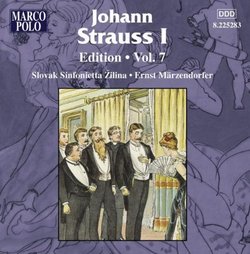| All Artists: Johann I [Senior] Strauss, Ernst Marzendorfer, Slovak Sinfonietta Title: Johann Strauss I Edition, Vol. 7 Members Wishing: 0 Total Copies: 0 Label: Marco Polo Original Release Date: 1/1/2006 Re-Release Date: 1/17/2006 Genres: Dance & Electronic, Classical Style: Symphonies Number of Discs: 1 SwapaCD Credits: 1 UPC: 636943528327 |
Search - Johann I [Senior] Strauss, Ernst Marzendorfer, Slovak Sinfonietta :: Johann Strauss I Edition, Vol. 7
 | Johann I [Senior] Strauss, Ernst Marzendorfer, Slovak Sinfonietta Johann Strauss I Edition, Vol. 7 Genres: Dance & Electronic, Classical
|
Larger Image |
CD Details |
CD Reviews"Cheerfulness My Aim" J Scott Morrison | Middlebury VT, USA | 02/05/2006 (5 out of 5 stars) "Johann Strauss I, the father of 'The Waltz King' Johann Strauss II, was in his day as famous as a rock star. He formed a dance band, which he led from the violin, and after they became a fixture in the social whirl of 1830s Vienna, he toured all over Europe, his fame having preceded him. He died at the relatively early age of 45 and his son, Johann II, who had been born when Johann I was only 21, succeeded him and went on to greater fame. Johann I, however, was a fine musician and a very talented composer. This is the seventh in the series of CDs devoted to his music. It is played with sparkle and verve by the Slovak Sinfonietta under Ernst Märzendorfer.
The program is arranged so that each waltz is followed by a galop (and in one instance by a march) so that there is rhythmic variety. The waltzes are generally composed of a string of separate waltz tunes that are sometimes combined and often reprised. One waltz, Emlék Pesth [Remembrance of Pest], fools us by starting out at a slow Gypsy two-step before devolving into a string of Hungarian-tinged waltzes. The Jugendfeuer-Galopp (Fire of Youth Galop) is one of Johann I's most famous works, probably because of its bouncy spirits and the memorable tunes that come tumbling out one after the other. Its good humor is palpable, which is appropriate because it was premièred at a summer festival called 'Humoristisches Lebensbild' '('Humorous Picture of Life'). The Cachuca-Galopp was inspired by a visit by the famous Elssler sisters, dancers who were all the rage. They had introduced a Spanish dance called the cachuca and Johann I, never one to let a fad pass him by, incorporated not only the cachuca rhythms but also castanets into his orchestration. It caught on and remained a popular fad for several years. One piece, the Boulogner-Galopp is an arrangement of tunes from 'L'Ambassadrice' ('The Ambassadress'), an operetta by the then-popular French composer, Daniel-François-Esprit Auber. Another, the Pfennig-Walzer (Penny Waltz) honors the popular Penny Magazine. Erinnerung an Berlin Walzer (Souvenir of Berlin Waltz) was written for the orchestra's first trip to Berlin and became a rage there and later back in Vienna. That trip was one of the early tours the orchestra took. Later, they began touring incessantly (like today's rock groups) and went as far as Paris and London, meeting with great acclaim everywhere they went. When a critic referred to Johann as a 'great artist' he responded by saying he had never intended to be an artist, that his only aim had been to bring cheerfulness to his audiences. And he followed that up by writing a waltz called Frohsinn mein Ziel (Cheerfulness My Aim). It's a shame that most people don't know any of the music of Johann Strauss I other than his familiar Radetsky March (the one that always features as the last number in the New Year's concerts of the Vienna Philharmonic). He was as talented as his more famous sons and can be credited with taking what he'd learned from his first boss, Josef Lanner, popularizing the waltz and then handing it on to Johann II, Josef and Eduard. You'll enjoy this CD, I can almost guarantee. Scott Morrison" |

 Track Listings (11) - Disc #1
Track Listings (11) - Disc #1